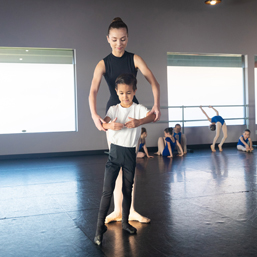
Despite an increase in male dancers in the media and popular television, boys who choose dance as a favorite activity are still subject to difficult questions and derogatory names.
Dance in all of its forms is often marketed as “for girls” when it comes time for parents to choose an extra-curricular for their kids, so boys who are interested in it can face bullying or barriers to participation from both children and adults. This can be extremely isolating and result in decreased self-confidence.
How can parents help their boys overcome this bias and thrive in dance?
Find the right dance studio
Some dance studios offer boys only classes or go above and beyond to welcome boys to their dance classes. Make sure to ask questions about how many other boys are in the class, what steps the dance instructor takes to help boys feel welcome, if there are any male instructors available and what options are available at higher levels for boys through the studio.
Susan Laing, the owner of Airdrie Dance Academy, says she has witnessed the struggles boys in dance can face since her now-grown son started dancing at age three.
She created a ‘boys only’ class for her students in 2004 when her then ten-year-old son asked if he could dance with other boys.
“Many boys who signed up were brothers of current dancers,” says Susan, who has owned the dance academy for 30 years. “They saw their sisters onstage at the recital and wanted a chance to experience that joy.”
She adds that she has taught hundreds of boys over the past 18 years, and has a male dance instructor assistant who is able to build deep connections with the dancers.
“The exercise, challenge, musicality, technique and teamwork are all things the boys look forward to in their classes,” says Susan. “Many of the boys I teach add other classes like musical theater, jazz, ballet, contemporary and tap to their schedules. Once they feel the joy of dance, they can't get enough!”
Susan adds that she is working with a number of other instructors to create their own boys’ only programs to open up the world of dance to all children who want to participate.
“Our boys only group this year was the top in their competition level [at the Danceworks/Central Alberta Dance Festivals competition],” Susan says. “The stigma of boys in dance has changed over the years and programs like mine help those kids experience the joy of dance!”
Find marvelous mentorship
The ability to see and speak to an adult or older teen thriving in their chosen sport can make all the difference to an enthusiastic beginner in any sport - and dance is no exception! It can be extremely beneficial for boys who love to dance to know that they are not alone and speak with men who have found success and happiness in the profession.
Another program that is working to create community, abolish social pressure and provide opportunities for aspiring male dancers is the Böys who Dance campaign.
The campaign, which was created in 2011, allows boys to be mentored one-on-one by the professional male dancers of Canada’s Ballet Jörgen (CBJ).
Mentees are matched with one of CBJ’s male dancers and meet virtually once a week.
CBJ dancer and mentor, Callum McGregor, says many boys who dance struggle to fit in as society doesn’t see male dancers as ‘normal.’
“Boys training to dance or dancing for fun face judgment, usually because it’s seen as something [hyper-feminine] and not something that men should do,” he adds.
“I see a lot of boys face bullying due to this, and it’s a cycle that seems to repeat itself over and over again. I have faced these issues, and yet boys who are five to ten years younger than me still are struggling with bullying and being victims of people’s ignorance.”
The Böys who Dance program has five mentors and is mentoring 11 young men between the ages of nine and 17.
Create and encourage a supportive environment
As parents, it’s our job to remain open-minded and unfailingly positive about whatever sports and activities our children want to pursue. Speak to grandparents, family members and friends and make sure they all understand that any negative comments or teasing will not be tolerated.
Remind any hesitant adults that their discomfort or bias against boys in dance is not based in reality. Ask them how they would feel if you had a daughter who chose to pursue football or hockey - would they have the same reaction? Why or why not? Why is it considered brave and impressive for a girl to attempt a sport which was traditionally limited to boys, but shameful for a boy to pursue an artistic sport like dance?
Through support from parents, peers, teachers and mentors, boys develop more self-confidence and are better equipped to overcome bullying. In turn, they are encouraged to model these positive behaviors and become role models themselves. Where possible, help your son make friends with other boys in the sport and encourage a healthy atmosphere of cooperation and teamwork where everyone can feel welcome and uplifted.
It is estimated that about 80 percent of dancers in Canada are female, leaving roughly 20 percent of those dedicated to the art identifying as male.
“Boys learn from role models to gain and own their self-confidence so they can have more power over bullying,” says Elise Tigges, community programs lead for CBJ.
“We want to do better as a society to show boys in dance that they can overcome negative comments and bullying and strive to be the best they can be. Let’s get our boys dancing because dance is for all.”
Calgary’s Child Magazine © 2024 Calgary’s Child